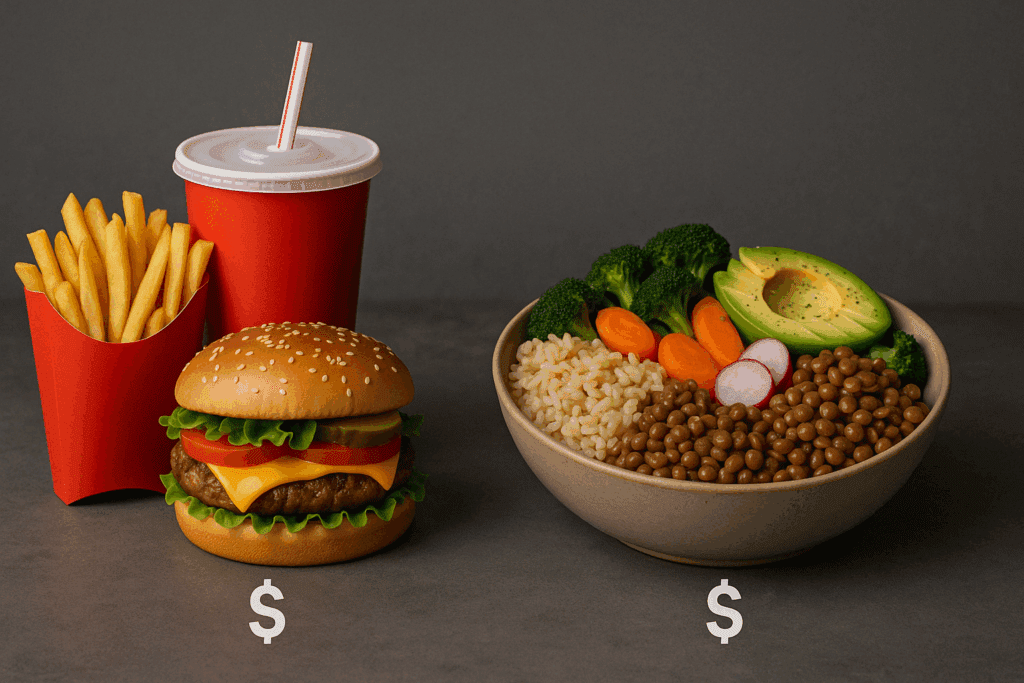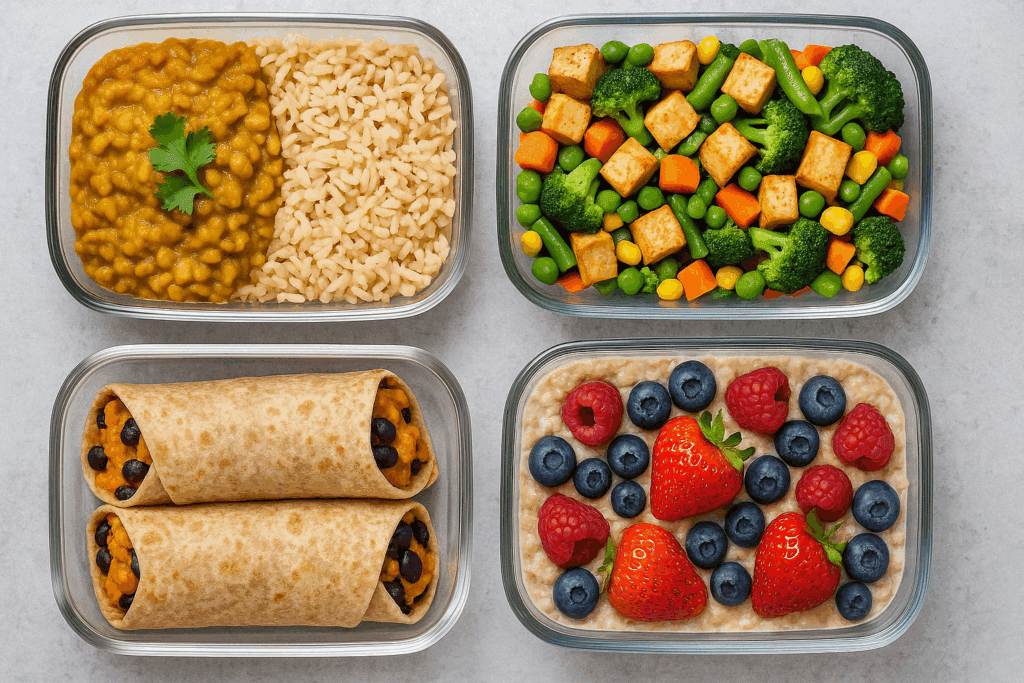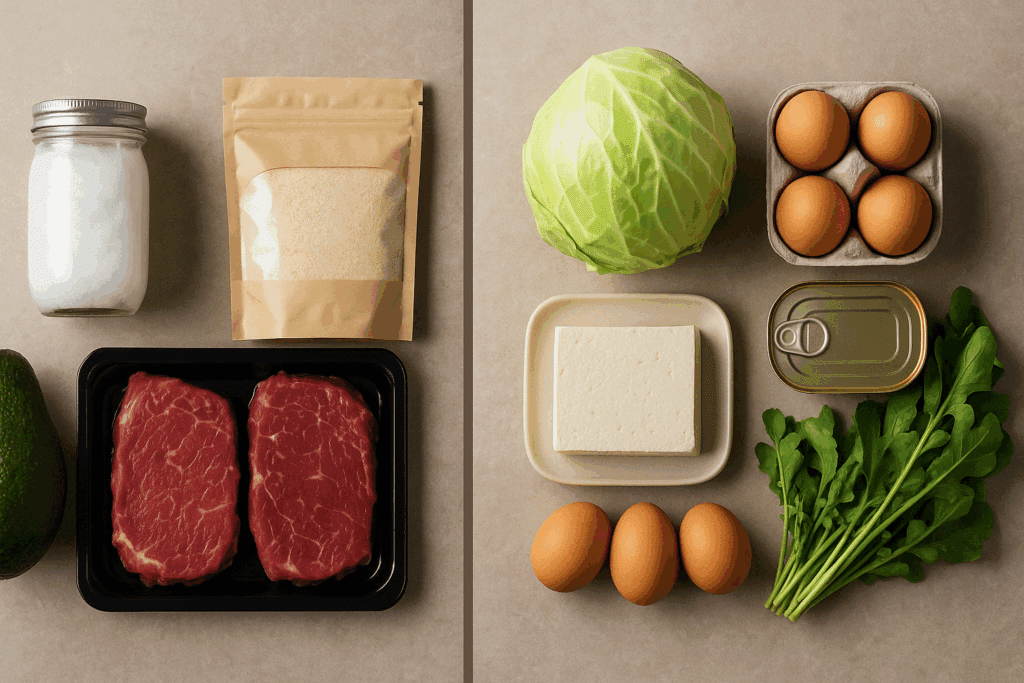In today’s fast-paced world, finding the time, energy, and financial bandwidth to consistently eat nutritious meals can feel like an overwhelming challenge. Many people assume that healthy eating comes with a hefty price tag, but the truth is, it doesn’t have to. With a bit of planning, creativity, and knowledge, you can create satisfying, nourishing meals that support both your health and your wallet. This article explores the art and science of healthy inexpensive meal prep, blending nutrition science with real-world practicality to help you craft cheap weekly meal plans that are as kind to your body as they are to your budget.
You may also like: Smart Meal Prep for Weight Loss: Expert-Approved Lunch Ideas and Recipes to Stay on Track
The True Cost of Eating Healthy: Debunking the Myth
The persistent myth that healthy food is prohibitively expensive often deters people from pursuing a better diet. While it is true that some organic and specialty items can carry higher price tags, many nutrient-rich whole foods—such as legumes, whole grains, seasonal produce, and frozen vegetables—are incredibly affordable. Moreover, unhealthy processed foods often cost more per nutrient and contribute to long-term health issues, which can lead to increased medical expenses. In this light, budget meal prep is not only an investment in your immediate well-being but also a strategic move for long-term health savings.
When we talk about a good budget for meal prep, it’s helpful to think in terms of cost per serving and nutrient density. For example, a $2.00 meal made with lentils, brown rice, and steamed broccoli may deliver more fiber, protein, and vitamins than a $5.00 fast food burger. With intentional planning, inexpensive meal prep can offer variety, balance, and flavor, dispelling the notion that cheap food prep is synonymous with bland or boring meals.
The Foundations of Budget-Friendly Nutrition
At the heart of every affordable meal prep strategy lies a strong foundation of whole, minimally processed ingredients. These foods are often sold in bulk, boast long shelf lives, and can be transformed into a multitude of meals. Staples like oats, canned beans, lentils, quinoa, brown rice, sweet potatoes, and frozen mixed vegetables serve as the cornerstone of cheap healthy food prep. These ingredients are not only inexpensive but also rich in macronutrients and micronutrients that support metabolic health, cognitive function, and immune resilience.
Equally important is the strategy of repurposing ingredients across multiple dishes to minimize waste and streamline costs. For instance, a single batch of roasted chickpeas can be used in a salad, a wrap, or a grain bowl. Likewise, a big pot of chili made from beans, tomatoes, and spices can stretch across multiple lunches or dinners, forming the basis of a cheap weekly meal plan that doesn’t feel repetitive.

Practical Tips for Easy Cheap Meal Prep at Home
Creating a successful meal prep routine doesn’t require hours in the kitchen or fancy gadgets. In fact, some of the most effective systems are also the simplest. Start by selecting two or three meals to batch cook at the beginning of the week. Choose recipes that store well in the fridge or freezer and maintain their flavor and texture when reheated. Think stews, casseroles, soups, stir-fries, and pasta bakes—all excellent candidates for cheap healthy meal prep.
Organize your cooking sessions with a basic workflow: prep all vegetables at once, cook grains in large batches, and roast or bake proteins simultaneously. Store meals in portioned containers to save time during busy weekdays and reduce the temptation to order takeout. This approach not only streamlines your time in the kitchen but also helps you stick to a budget friendly meal prep routine that delivers consistent results.
How to Build a Cheap Menu Plan That Works
A successful cheap menu plan starts with an inventory of what you already have. Check your pantry, freezer, and fridge to identify usable ingredients. From there, look for simple recipes that complement your existing supplies. This not only cuts costs but also helps prevent food waste. Once you have a core set of recipes, rotate them every two to three weeks to keep things fresh without increasing expenses.
Portion planning is another key component. Over-prepping can lead to spoilage, while under-prepping increases the likelihood of buying convenience foods. Tailor your cheap meal prep meals to your household size and eating habits. If you’re prepping for one, a cheap weekly meal plan for 1 might include single-serving mason jar salads, overnight oats, or freezer-friendly portions of soup that can be thawed as needed.

Smart Grocery Shopping: The Key to Low Cost Meal Prep
Your meal prep success hinges on smart shopping strategies. Focus on buying in bulk when it makes sense—items like brown rice, dried beans, oats, and frozen fruits can be much cheaper per unit when purchased in larger quantities. Avoid shopping while hungry, and always go in with a list based on your meal plan. This helps you resist impulse purchases that can derail your budget.
Discount stores, farmers markets, and ethnic grocery stores are often treasure troves for affordable ingredients. When shopping for fresh produce, choose in-season varieties, which are typically more flavorful and less expensive. Frozen vegetables are another excellent option for cheap food prep, as they retain much of their nutritional value while offering convenience and long shelf life.
Maximizing Flavor Without Increasing Cost
One of the biggest misconceptions about inexpensive meal prep ideas is that they lack flavor. In reality, flavor can be built economically with the right use of herbs, spices, and sauces. Garlic, onion, cumin, smoked paprika, and nutritional yeast can transform basic dishes into something truly satisfying. A few drops of soy sauce, lemon juice, or vinegar can brighten up vegetables and grains, while a dollop of hummus or tahini adds creaminess and depth to bowls and wraps.
Meal prep doesn’t mean sacrificing variety, either. Rotate flavor profiles weekly—Mexican-inspired one week, Mediterranean the next, and maybe Asian flavors after that. This approach keeps meals exciting and prevents palate fatigue, even when using the same base ingredients.
Meal Prep Ideas on a Budget That Actually Work
Let’s talk real meals. A simple lentil curry served with brown rice can cost under $1.50 per serving and provides protein, fiber, iron, and B vitamins. Stir-fried tofu with frozen vegetables and soba noodles is another low-cost powerhouse. Sweet potato and black bean burritos can be batch-cooked and frozen, making them perfect for cheap lunch prep during busy workweeks.
For breakfast, overnight oats made with plant milk, chia seeds, and fruit offer a balanced start to the day and can be customized endlessly. Cheap meal prep recipes for snacks might include homemade popcorn, trail mix from bulk bins, or roasted chickpeas with spices. These are satisfying, nourishing, and far more affordable than processed alternatives.

How to Make Cheap Healthy Meals for a Week
To plan cheap healthy meals for a week, start with a spreadsheet or notebook where you map out breakfast, lunch, dinner, and snacks for each day. Assign a few recipes that can stretch across multiple meals. For example, a big pot of black bean soup might serve for two lunches and one dinner. Combine it with brown rice one day and avocado toast another.
Repurpose ingredients like cooked quinoa into a grain bowl, a side dish, and a salad topping. Roasted vegetables can go into wraps, serve as sides, or be blended into soup. By overlapping ingredients and planning ahead, your cheap meal prep becomes more efficient and less monotonous.
Budget Meal Prep and the Role of Dietary Patterns
When discussing affordable meal prep, it’s important to consider how different dietary frameworks influence costs and health outcomes. Many people today explore the intersection of budget friendly meal prep with dietary trends like vegetarianism, plant-based eating, or low carbohydrate diets. Each approach offers unique benefits and considerations.
One growing area of debate is the comparison between ketogenic diets and general low-carb diets. While the ketogenic diet is high in fat and very low in carbohydrates, a low-carb diet is more flexible and may include higher levels of non-starchy vegetables, legumes, or whole grains. Understanding the differences in the ketogenic diet vs low carb diets can inform your approach to meal planning, particularly when cost and health are top of mind.

Is Keto a Low Carb Diet? Clarifying Confusion for Meal Preppers
It’s a common question: is keto a low carb diet, or are they two distinct approaches? The answer is nuanced. All ketogenic diets are low carb, but not all low carb diets are ketogenic. A standard keto meal plan includes less than 50 grams of carbohydrates per day, which puts the body into a state of ketosis where fat is burned for energy. In contrast, a low carb diet might allow for 100 to 150 grams of carbohydrates and still provide health benefits, including improved insulin sensitivity and weight control.
For budget-conscious meal preppers, this distinction matters. Keto-friendly ingredients like almond flour, coconut oil, and grass-fed meat can be expensive. Conversely, a more moderate low carb diet can rely on affordable staples like eggs, leafy greens, cabbage, tofu, and canned fish. Understanding this helps you create low cost meal prep strategies that fit your dietary goals without overspending.
Is Keto a Good Diet When You’re on a Budget?
Whether keto is a good diet depends on your health goals, lifestyle, and financial flexibility. There is promising evidence suggesting that ketogenic diets can support short-term weight loss, reduce appetite, and stabilize blood sugar. However, the cost of maintaining a strict keto regimen can be significant. The need for specialized ingredients, high-fat animal products, and low-carb alternatives to staples like bread and pasta often leads to higher grocery bills.
If you’re drawn to keto but limited by finances, a budget meal prep plan that leans more toward the low carb diet keto diet hybrid approach may be more sustainable. This allows you to incorporate affordable vegetables, some legumes in moderation, and less expensive protein sources like eggs or canned salmon while still keeping carb intake low enough for metabolic benefits.
Evaluating the Sustainability of Keto for Long-Term Health
Many nutrition professionals ask: is a keto diet sustainable? The answer lies in individual variability. While some people thrive on a ketogenic diet for years, others may experience fatigue, digestive discomfort, or nutrient gaps if not properly balanced. Sustainability also includes financial factors. If your meal plan is not cost-effective, it becomes harder to maintain over time.
Moreover, keto is not a no-carb diet. Despite the common question “is keto no carbs,” even ketogenic plans include small amounts of carbs from leafy greens, nuts, seeds, and non-starchy vegetables. These foods provide fiber, antioxidants, and key micronutrients essential for long-term health.
Healthy Inexpensive Meal Plans for Every Lifestyle
Ultimately, successful meal planning hinges on aligning your nutritional needs, lifestyle, and budget. Healthy inexpensive meal plans are adaptable to various preferences, whether you’re a busy student, a working parent, or someone managing chronic conditions. By focusing on plant-forward, minimally processed foods, you can design budget friendly meal prep systems that support physical energy, mental clarity, and emotional well-being.
To stay consistent, it helps to treat meal prep like a ritual. Set aside a specific time each week to shop, cook, and portion meals. Use this time to experiment with new inexpensive meal prep recipes, get creative with leftovers, and refine your routines. This sense of structure and intentionality can be empowering, helping you stay on track with both your nutritional goals and your financial limits.
Crafting Weekly Meals on a Budget Without Sacrificing Nutrition
When designing weekly meals on a budget, variety and balance are key. A single pot of vegetable soup might meet your fiber needs, but pairing it with whole grain toast and a dollop of hummus boosts protein and satiety. Likewise, a baked sweet potato topped with black beans, salsa, and avocado offers a mix of complex carbs, plant protein, and healthy fats—a satisfying, low-cost combo that doesn’t compromise flavor or nutrition.
The cheapest meal prep doesn’t mean the least enjoyable. Instead, it calls for mindfulness, resourcefulness, and a willingness to plan ahead. You can enjoy diverse meals throughout the week while sticking to a tight grocery budget. The secret lies in combining nutrient-dense foods with cooking techniques that bring out flavor and texture.

Frequently Asked Questions: Smart and Simple Healthy Inexpensive Meal Prep
1. How can I make cheap meal prep feel exciting and not repetitive?
Many people associate cheap meal prep with bland, monotonous meals, but incorporating variety doesn’t have to increase your grocery bill. One effective strategy is to rotate global flavor profiles each week—for example, Mexican-inspired beans and rice one week, Mediterranean lentil salad the next, and Asian-style stir-fried noodles after that. These meals rely on inexpensive staples while adding diversity through low-cost seasonings and sauces. A good budget for meal prep includes room for small amounts of flavor-boosting ingredients like soy sauce, vinegar, or lime juice, which elevate taste without adding much cost. By prepping base ingredients like grains and legumes in bulk and changing how you season and serve them, your cheap meal prep ideas can stay both fun and affordable.
2. What are some smart ways to stretch protein in cheap healthy meal prep?
Protein can be one of the most expensive elements in a budget meal prep plan. To keep things affordable, try combining animal and plant proteins. For example, mix lentils or beans into ground meat dishes to create budget friendly meal prep options that offer satiety and nutrition. Eggs, tofu, and canned tuna are all excellent low-cost proteins that work well in cheap meal prep meals. You can also use techniques like marinating tofu or baking eggs into frittatas to create flavorful, inexpensive meal prep recipes that last several days. The key is to treat protein as a complement rather than the centerpiece, especially when aiming for the cheapest meal prep solutions.
3. Is it realistic to follow a cheap weekly meal plan for 1 without wasting food?
Absolutely—meal prepping for one is not only realistic but also highly customizable. The secret is to focus on versatile ingredients that can be used in multiple ways throughout the week. For example, cook a batch of quinoa that you can enjoy in salads, bowls, and stir-fries. Portion control is essential when creating a cheap weekly meal plan for 1, so store food in individual containers to reduce spoilage. Additionally, freezing half-portions of your cheap healthy meals for a week ensures nothing goes to waste while still benefiting from your initial effort. Even with a small household, inexpensive meal prep ideas can be scaled smartly to meet your needs.
4. How do I know if I’m following the cheapest food prep strategy possible?
While there’s no universal benchmark, several signs indicate you’re on the right track. If your meals average under $2 per serving, you’re likely engaging in the cheapest meal prep practices. Shopping bulk bins, avoiding single-use packaged snacks, and planning meals around sales are all hallmarks of cheap food prep. Monitoring your food waste can also be telling—low waste typically means your cheap meal prep recipes are efficient and well-structured. For added assurance, compare your grocery receipts over time to assess trends and identify areas where you can tighten your budget further. A smart, low cost meal prep plan evolves with your habits and preferences.
5. Are there psychological or lifestyle benefits to budget meal prep?
Yes, beyond saving money, budget meal prep contributes to mental clarity and reduced stress. Knowing what you’ll eat in advance eliminates decision fatigue, a common cause of unhealthy impulse eating. Planning a cheap menu plan for the week can also support goal setting and accountability, especially if you’re pursuing health or fitness goals. The act of cooking itself can be therapeutic, creating a mindfulness ritual that promotes well-being. From a social standpoint, sharing easy cheap meal prep meals with others—even virtually—can foster community and shared learning. These benefits make healthy inexpensive meal prep valuable not only for your wallet but for your emotional health.
6. How can I design cheap lunch prep strategies that work for office or remote work?
For cheap lunch meal prep that travels well, opt for meals that are delicious cold or reheat easily. Grain bowls, pasta salads, and wraps filled with roasted vegetables or legumes are ideal for portability and freshness. Use durable, leak-proof containers to avoid mess and plan meals that require minimal assembly. One great option for remote workers is prepping base ingredients that can be quickly combined based on what you feel like each day—this offers flexibility within your weekly meals on a budget. Whether you’re packing lunch for the office or prepping at home, these inexpensive meal prep recipes help ensure you’re never caught without a nourishing option.
7. How can families implement a cheap weekly meal plan without overwhelming the cook?
For families, the key is collaboration and simplicity. Choose 3–4 core dishes per week and rotate ingredients creatively to avoid boredom. Involving kids in meal selection or prep not only teaches life skills but also reduces resistance to new foods. Dishes like sheet pan dinners, slow cooker meals, and soups are excellent cheap healthy food prep options that serve multiple people with minimal effort. Batch cooking on weekends and freezing half of what you make also reduces daily cooking stress. By turning meal prep into a family activity, even the busiest households can enjoy affordable meal prep that supports both nutrition and connection.
8. Can meal prep ideas on a budget support athletic or high-protein diets?
Yes, meal plans for cheap can absolutely meet the needs of active individuals or those aiming to increase protein intake. Budget-friendly proteins like eggs, lentils, chickpeas, and even whey or plant-based protein powder can be included in cheap healthy meal prep routines. Pairing these with calorie-dense foods like oats, sweet potatoes, and nut butters helps meet higher energy needs without exceeding your food budget. Prepping smoothies, protein bars, or bulk stir-fry meals ensures you’re not scrambling for post-workout fuel. Whether you’re a runner, weightlifter, or simply very active, healthy inexpensive meal plans can be adjusted to support performance and recovery.
9. What are some emerging trends or tools that support inexpensive meal prep?
Technology is playing a growing role in how we approach affordable meal prep. Budget meal planning apps now offer recipe suggestions based on your pantry, track ingredient prices, and generate shopping lists. There are also online communities dedicated to cheap meal prep ideas, where members share real-world tips, swaps, and success stories. In addition, more grocery stores are embracing bulk stations and plant-based meal kits geared toward inexpensive meal prep. Innovations like air fryers and multi-cookers make it easier than ever to prepare cheap meal prep meals quickly and with less cleanup. These tools empower users to build smarter, cheaper, and healthier routines.
10. How do I transition from sporadic cooking to consistent budget friendly meal prep?
Shifting from occasional cooking to a routine cheap meal prep strategy starts with mindset and small wins. Begin by planning just three dinners per week and scaling up as you get comfortable. Keep a running list of your favorite inexpensive meal prep recipes so you always have go-to options. Create rituals—such as Sunday evening cooking sessions or Thursday fridge cleanouts—that help anchor your meal prep in your weekly schedule. Over time, as you recognize the financial and health benefits, budget friendly meal prep becomes second nature. Eventually, your kitchen becomes a space of empowerment rather than stress, where meal prep ideas on a budget flourish week after week.

Conclusion: How Healthy Inexpensive Meal Prep Helps You Eat Well for Less
Mastering the art of healthy inexpensive meal prep is not just about saving money—it’s about reclaiming control over your food choices, your time, and your well-being. Whether you’re exploring meal prep ideas on a budget to cut costs, curious about the ketogenic diet vs low carb plans, or simply looking for affordable ways to nourish yourself, the tools and strategies shared here empower you to thrive.
With a little effort and foresight, you can build cheap meal prep recipes that support sustained energy, mental clarity, and physical health. And while debates like keto diet vs low carb diet or questions like “is keto a good diet” are worth exploring, the ultimate goal is finding a plan that fits your life—nutritionally, financially, and emotionally.
So whether you’re crafting a cheap weekly meal plan for 1 or feeding a household on a budget, remember that healthy eating doesn’t have to be expensive, complicated, or time-consuming. With smart planning, a few core ingredients, and an open mind, you can create delicious, affordable meals that nourish your body and respect your budget every day.
Was this article helpful? Don’t let it stop with you. Share it right now with someone who needs to see it—whether it’s a friend, a colleague, or your whole network. And if staying ahead on this topic matters to you, subscribe to this publication for the most up-to-date information. You’ll get the latest insights delivered straight to you—no searching, no missing out.
Further Reading:
19 Ways to Eat Healthy on a Tight Budget
How to Meal Prep Without Going Broke, From Someone Who’s Done It for Years
Disclaimer
The information contained in this article is provided for general informational purposes only and is not intended to serve as medical, legal, or professional advice. While NewsHealthWatch strives to present accurate, up-to-date, and reliable content, no warranty or guarantee, expressed or implied, is made regarding the completeness, accuracy, or adequacy of the information provided. Readers are strongly advised to seek the guidance of a qualified healthcare provider or other relevant professionals before acting on any information contained in this article. NewsHealthWatch, its authors, editors, and contributors expressly disclaim any liability for any damages, losses, or consequences arising directly or indirectly from the use, interpretation, or reliance on any information presented herein. The views and opinions expressed in this article are those of the author(s) and do not necessarily reflect the official policies or positions of NewsHealthWatch.

